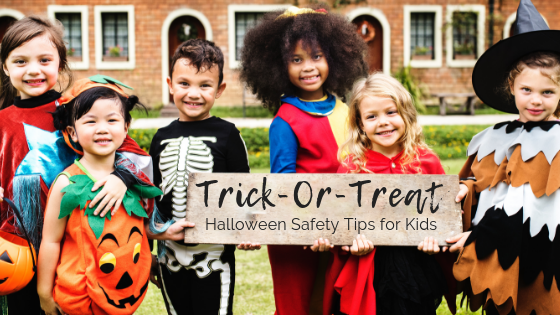Halloween is a fun and exciting time of year for kids. From candy to costumes, the memories made at Halloween can last a lifetime. However, it can also cause some anxiety for parents trying to keep their children safe, and while trick-or-treating and dressing up can be exciting. Parents can agree that safety should come first. That’s why we’ve gathered some essential Halloween safety tips to help you and your family enjoy a fun and worry-free holiday!
Halloween Candy Safety Tips
While it can be so exciting to return home with a bag full of candy, it’s important that a trusted adult checks to ensure everything is safe to eat. Here are some of the things you should look out for when checking your child’s Halloween candy:
- Homemade items (unless from a trusted household)
- Unwrapped candy or wrapping with holes
- Expired items
- Choking hazards or candy with small pieces
- Food allergies
Costume Safety
Halloween costumes are all about creativity, but they need to be practical, too! Here are some costume safety tips to keep in mind:
- Ensure proper visibility with masks and face paint: While masks can complete a costume, they often obstruct a child’s vision, increasing the risk of falls or accidents. Instead, consider using non-toxic face paint or makeup, which allows your child to see clearly. It is best to avoid masks with small eye holes. If using face paint, test face paint on a small patch of skin first to ensure your child doesn’t have an allergic reaction.
- Reflective gear and glow sticks for visibility: Halloween festivities often last into the evening, so it’s important to ensure that your child is easily visible in the dark. Adding reflective tape or stickers to their costumes or candy bags can help drivers spot them. Glow sticks or small flashlights are another great option for keeping them visible, and they can even add a fun, spooky effect to costumes.
- Comfort is key: While it’s tempting to choose elaborate costumes, remember that your preschooler will likely be wearing it for several hours. Make sure the costume is comfortable, isn’t too tight or itchy, and allows for free movement. Comfortable shoes are a must, and it’s a good idea to layer clothing underneath if it’s a chilly evening. Overly elaborate costumes with multiple pieces or heavy accessories can weigh a child down and make them tired quickly.
How to Safely Prepare Your House for Trick-or-Treaters
If you plan on welcoming trick-or-treaters to your home, it’s important to make sure your property is safe and accessible:
- Keep walkways clear of hazards: To ensure a safe experience for trick-or-treaters visiting your home, make sure your yard, driveway, and porch are well-lit and free of tripping hazards like toys, hoses, or decorations. It’s important to remove anything that could cause someone to trip, such as outdoor furniture or garden tools. Illuminating your walkway with lanterns or string lights is a festive and practical way to ensure your home is safe for visiting children.
- Pet safety precautions: While pets may enjoy the excitement of Halloween, the constant ringing of the doorbell and the presence of strangers can be overwhelming for them. For the safety of both pets and visitors, the SPCA recommends keeping pets in a secure, quiet area of the home during trick-or-treating hours. Even the friendliest pets can become frightened by costumed visitors and may act out of character, leading to accidental bites or escapes.
- Consider allergy-safe treats: If you’re handing out candy, consider providing non-food treats for children with allergies. Participating in the Teal Pumpkin Project (described in greater detail below) is a great way to show families that your home offers safe alternatives for children with food allergies. Simply place a teal-colored pumpkin outside your door to signal that you’re offering non-food treats.
Food Allergies and Safe Treats
For families with children who have food allergies, Halloween can be a bit more stressful. Thankfully, there are plenty of ways to make Halloween safer and more inclusive for everyone:
- Participate in the Teal Pumpkin Project: If you haven’t heard of the Teal Pumpkin Project, it’s an initiative started by Food Allergy Research & Education (FARE) to help ensure that all children, including those with food allergies, can participate in trick-or-treating. By offering non-food treats, you can help create a safer and more inclusive environment for all children. It’s as simple as placing a teal pumpkin outside your home to indicate that you’re participating. Non-food treats can be anything from stickers to small toys or even glow sticks!
- Always read labels: For parents of children with food allergies, it’s crucial to read the labels of all treats before allowing them to indulge. Many common Halloween candies contain allergens like peanuts, tree nuts, dairy, or gluten, and some candies may not have clear labeling. The FARE website offers helpful tips on what to look for in ingredient lists and how to ensure your child’s safety while still enjoying the holiday. If in doubt, stick to candies that are known to be safe or opt for non-food treats.
- Be prepared for food allergy emergencies: Even with careful planning, accidents can happen. If your child has severe food allergies, make sure to carry an epinephrine auto-injector and have it easily accessible while trick-or-treating. Let your child’s friends and the adults supervising them know about their allergies and be vigilant about checking treats before consumption.
Conclusion
Halloween is a memory your children will cherish into their adulthoods, and as parents, we play an important role in ensuring it’s a happy and secure memory. From trick-or-treating safety to costume considerations, following these simple Halloween safety tips can help you and your little one enjoy a fun and memorable holiday. Little Sunshine’s wishes you all a spooky and safe Halloween!

